- Joined
- May 1, 2008
- Messages
- 3,563
Martin Rapaport's "State of the Diamond Industry" presentation at JCK Las Vegas is a much-anticipated event. His 2011 theme discussed change, the "new normal" and the "new abnormal." Here is a short review, for those interested. (The full 99-minute video can be seen here)
* * * * *
“The USA, with regard to how we fit into the global diamond industry, is fundamentally screwed.”
– Martin Rapaport
One can always count on Martin Rapaport to cut to the chase. His 2011 “State of the Diamond Industry” presentation in June was no exception. And while his personal delivery may occasionally employ the tone and cadence of someone preaching from a barroom soapbox his basic conclusions can’t be denied. In fact, Rapaport could have sprinkled slides throughout his lecture proclaiming “I told you so!” since he has forecast many aspects of today’s global macroeconomic situation since 2005.
Non-Linear Interactive Change
Rapaport reports that our world is undergoing “non-linear interactive change.” These are unexpected changes which are interactive: A affects B, B affects G, G affects Z, Z affects A, etc. A naturally-occurring example of such change would be the Tsunami in Japan in March. With regard to the diamond and jewelry industry, there are “non-linear interactive changes” in demographics, economics and globalization which are bringing about a new and unavoidable reality that we must cope-with.
Demographics
Where the USA used to dominate the diamond and jewelry industry Rapaport says it simply will not be the main player anymore. He supported this assertion with data from different world markets. The USA and Europe are mature markets; we already own diamonds. But China and India are producing 80 million new consumers every year. These new consumers can afford diamonds for the first time and they want them. When you couple this rising demand from countries with little diamond saturation with the fact that there are no new mines it means demand and prices will continue to rise. Free market forces have already driven prices up notably in the last few years and all signs point to this as a steady trend.
Many people are undergoing shock about this. They think the situation is temporary or speculative and things will go back to the way they were. Rapaport says they are in denial: “Don’t build your business on things returning to the way they were. There is new normal. There is new abnormal. It’s necessary to surf the ways of change.” He believes it will be necessary to identify and take advantage of your unique sales propositions (USPs) to add value and adapt to global demographics which are in the process of steady change.
Economics
Rapaport says we are living in a time of resource and economic warfare where currency is the primary weapon. The outlook for the dollar is down, but for diamonds it’s up - and every time the dollar goes down diamond prices go up relative to its weakening. American consumers are being forced to pay rising prices as the dollar loses value against the RMB “...and if anyone thinks the RMB is going to stay where it is that’s a mistake” he says. American jewelers are no longer competing just with the guy across the street, but also with Chinese and Indian suppliers. “The Chinese and Indian suppliers want your customers’ diamonds for their own customers, and their currency is only getting stronger.”
The economic outlook in America is not promising: “We allocate money through interest rates. We have lowered interest rates in America to a ridiculous degree. We’re financing a nation with artificially low interest rates. This makes our money worth less.” He maintains that gas prices have not gone up, it’s the dollar which has gone down and become worth less. “We’re out of gas in terms of monetary policy” he says. “We can’t raise interest rates because that creates more unemployment. We lowered interest rates to zero and expected things to grow but it’s been tiny growth. We may get into a position where 30% of Americans make all the money and we throw healthcare and welfare at the rest.”
Globalization
“Africa is the new India. India is the new America... Where is America?”
Rapaport points out that in the 1970s the USA formalized relations with China. There was a great effort to assist them economically in order to prevent a situation where the world’s most populous country would be forced to consider resorting to violence to feed its people. “We’ll buy from China so they don’t kill us.” He points out that we organized things in such a way that it generated many jobs for the Chinese and Indians. “We lowered interest rates and bought more foreign-made goods and now we are in a weird position.” Moreover, it is not just China and India that have rising economies, Rapaport says. “Brazil is also rocking...and all these guys want your diamonds.”
Rapaport predicts that the artificial US “party” with the dollar will end badly when interest rates rise and inflation occurs. He says this may be three to five years away, but strongly feels it will happen. We and other countries are currently vying for the same commodities using currency and buying-power as weapons of choice. “As long as there is music we will dance, but it’s musical chairs. Get your eyes on a chair because when the music stops there won’t be a chair for everyone.”

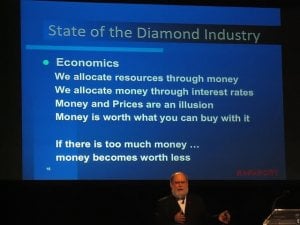
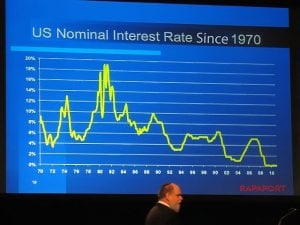
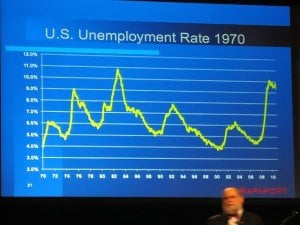
* * * * *
“The USA, with regard to how we fit into the global diamond industry, is fundamentally screwed.”
– Martin Rapaport
One can always count on Martin Rapaport to cut to the chase. His 2011 “State of the Diamond Industry” presentation in June was no exception. And while his personal delivery may occasionally employ the tone and cadence of someone preaching from a barroom soapbox his basic conclusions can’t be denied. In fact, Rapaport could have sprinkled slides throughout his lecture proclaiming “I told you so!” since he has forecast many aspects of today’s global macroeconomic situation since 2005.
Non-Linear Interactive Change
Rapaport reports that our world is undergoing “non-linear interactive change.” These are unexpected changes which are interactive: A affects B, B affects G, G affects Z, Z affects A, etc. A naturally-occurring example of such change would be the Tsunami in Japan in March. With regard to the diamond and jewelry industry, there are “non-linear interactive changes” in demographics, economics and globalization which are bringing about a new and unavoidable reality that we must cope-with.
Demographics
Where the USA used to dominate the diamond and jewelry industry Rapaport says it simply will not be the main player anymore. He supported this assertion with data from different world markets. The USA and Europe are mature markets; we already own diamonds. But China and India are producing 80 million new consumers every year. These new consumers can afford diamonds for the first time and they want them. When you couple this rising demand from countries with little diamond saturation with the fact that there are no new mines it means demand and prices will continue to rise. Free market forces have already driven prices up notably in the last few years and all signs point to this as a steady trend.
Many people are undergoing shock about this. They think the situation is temporary or speculative and things will go back to the way they were. Rapaport says they are in denial: “Don’t build your business on things returning to the way they were. There is new normal. There is new abnormal. It’s necessary to surf the ways of change.” He believes it will be necessary to identify and take advantage of your unique sales propositions (USPs) to add value and adapt to global demographics which are in the process of steady change.
Economics
Rapaport says we are living in a time of resource and economic warfare where currency is the primary weapon. The outlook for the dollar is down, but for diamonds it’s up - and every time the dollar goes down diamond prices go up relative to its weakening. American consumers are being forced to pay rising prices as the dollar loses value against the RMB “...and if anyone thinks the RMB is going to stay where it is that’s a mistake” he says. American jewelers are no longer competing just with the guy across the street, but also with Chinese and Indian suppliers. “The Chinese and Indian suppliers want your customers’ diamonds for their own customers, and their currency is only getting stronger.”
The economic outlook in America is not promising: “We allocate money through interest rates. We have lowered interest rates in America to a ridiculous degree. We’re financing a nation with artificially low interest rates. This makes our money worth less.” He maintains that gas prices have not gone up, it’s the dollar which has gone down and become worth less. “We’re out of gas in terms of monetary policy” he says. “We can’t raise interest rates because that creates more unemployment. We lowered interest rates to zero and expected things to grow but it’s been tiny growth. We may get into a position where 30% of Americans make all the money and we throw healthcare and welfare at the rest.”
Globalization
“Africa is the new India. India is the new America... Where is America?”
Rapaport points out that in the 1970s the USA formalized relations with China. There was a great effort to assist them economically in order to prevent a situation where the world’s most populous country would be forced to consider resorting to violence to feed its people. “We’ll buy from China so they don’t kill us.” He points out that we organized things in such a way that it generated many jobs for the Chinese and Indians. “We lowered interest rates and bought more foreign-made goods and now we are in a weird position.” Moreover, it is not just China and India that have rising economies, Rapaport says. “Brazil is also rocking...and all these guys want your diamonds.”
Rapaport predicts that the artificial US “party” with the dollar will end badly when interest rates rise and inflation occurs. He says this may be three to five years away, but strongly feels it will happen. We and other countries are currently vying for the same commodities using currency and buying-power as weapons of choice. “As long as there is music we will dance, but it’s musical chairs. Get your eyes on a chair because when the music stops there won’t be a chair for everyone.”









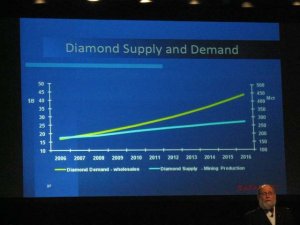
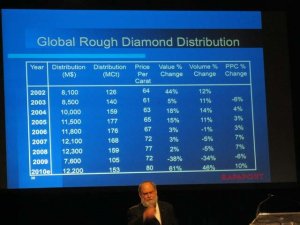
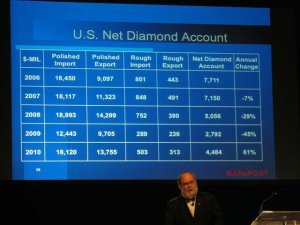
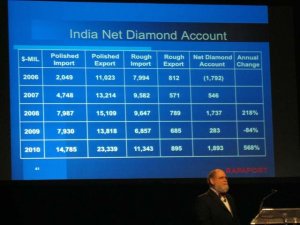
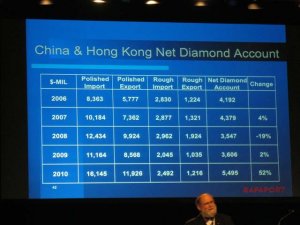
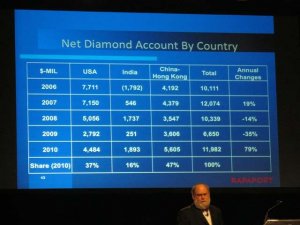
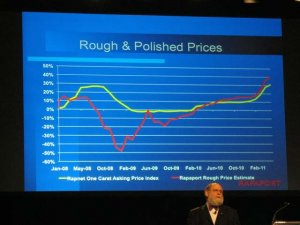
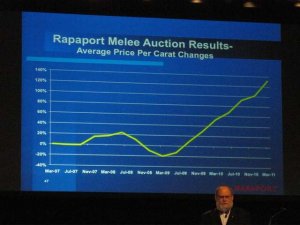
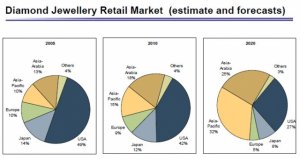
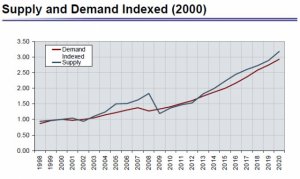
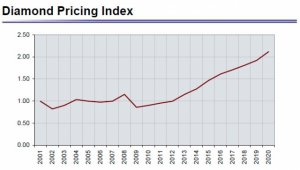


300x240.png)